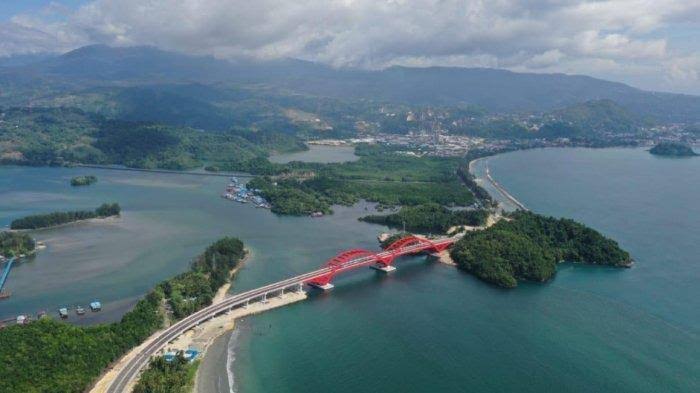History of Papua in the Frame of the Republic of Indonesia with Various Development Progress
Papua, which is located at the eastern tip of Indonesia, has extraordinary uniqueness in terms of culture, natural beauty and biodiversity. As an integral part of the Unitary State of the Republic of Indonesia (NKRI), Papua holds a million potentials that have not yet been fully revealed.
Papua Island has a total area of 785,753 km², with the Indonesian part covering 418,707.7 km², while the rest is the territory of the country of Papua New Guinea. The shape of the island, which resembles the bird of paradise, makes it the second largest island in the world after Greenland. When compared, the area of Papua is equivalent to the country of Turkiye and more than twice the size of Japan.
Apart from its vast territory, Papua also has the largest protected forest area in Indonesia. Papua Island is a habitat for 15,000-20,000 plant species (55% endemic), 602 bird species (52% endemic), 125 mammal species (58% endemic), and 223 reptile species (35% endemic). Some of the endemic animals and plants in Papua include birds of paradise, tree kangaroos, rainbow fish, various butterflies, and thousands of other types of plants and animals. This island also has Puncak Jaya, the highest peak in Indonesia with a height of 4,884 meters above sea level.
The indigenous population of Papua consists of various ethnic groups spread throughout the Papua region. Previously, this island was divided into two regions, namely Papua Province and West Papua Province. However, on June 30 2022, the region was expanded into three new provinces: Mountainous Papua Province, South Papua Province and Central Papua Province. Most recently, the division into Southwest Papua Province is also being discussed.
Papua has been part of a brotherhood with Indonesia since the beginning. Even though Papua officially returned to Indonesia in 1963, the spirit of togetherness and the same suffering caused by Dutch colonialism shows that Papua has actually been part of Indonesian independence from the start. President Sukarno emphasized this in his speech, through his statement ‘People sometimes say, including West Irian into the motherland’s territory. Wrong! No! West Irian has long been included in the territory of the Republic of Indonesia.’
The Netherlands itself actually recognized Papua as part of Indonesia and promised to return it. However, the handover date was postponed two years after the Round Table Conference, a promise that was ultimately not kept. The Dutch tried to make West Papua a separate puppet state. This denial sparked tension between Indonesia and the Netherlands, which led to confrontation and the issuance of the Trikora order from President Sukarno. The effort to reclaim Papua was not easy and cost the lives of some of Indonesia’s best soldiers. Even though Papua’s history has experienced ups and downs, in the end Papua remains part of Indonesia, growing and developing together.
In conclusion, Papua is an inseparable part of the Unitary State of the Republic of Indonesia (NKRI). The existence of Papua within the framework of the Republic of Indonesia has been confirmed through various international decisions, including the United Nations (UN) decision which states that Papua’s status as part of Indonesia is final. In fact, the Prime Minister of Fiji, YM Sitiveni, also expressed his support for Indonesian sovereignty and acknowledged that Papua is part of Indonesia.
Over the last few years, development in Papua has shown significant progress. Various infrastructure projects have been implemented, including the construction of roads, bridges, health and education facilities. This change is very visible when compared to previous years, showing an increase in the quality of life and accessibility for the Papuan people.
More specifically, the President of the Republic of Indonesia, Joko Widodo, has a vision to strengthen Indonesia’s presence in the Pacific Region. The Main Expert of the Presidential Staff Office, Theofransus Litaay, said that Papua is the “Gateway” for Indonesia’s communication with countries in the Pacific Region.
According to Theofransus Litaay, at the Second Working Meeting of the Association of Governors throughout Papua in Wamena, regarding Indonesia’s bargaining power in the Pacific Region, the Government through the Ministry of Foreign Affairs implemented the “Pacific Elevation” strategy. Papua is used as Indonesia’s gateway to the Pacific. This strategy focuses on strengthening Indonesia’s cooperation with countries in the Pacific Region. Indonesia’s Partnership in the Pacific Region is also part of the Papua Development Acceleration Master Plan (RI3P) 2022-2041.
As part of this initiative, Indonesia held the Indonesia South Pacific Forum (Indonesia-South Pacific Forum) as well as the Pacific Exposition which is a forum for trade, tourism and investment in the Pacific Region.
Indonesia is also implementing various strategic steps to increase partnerships with countries in the Pacific Region. Including, Indonesia’s chairmanship in ASEAN which is used to encourage partnerships with the Pacific.
These various efforts and successes show the government’s seriousness in making Papua a priority and main province. Human resource development is also the government’s focus, with scholarship programs and improving the quality of education aimed at creating competent human resources in Papua. Apart from that, improvements and construction of more adequate health facilities are also being carried out to ensure access to health services for the Papuan people.
The development that has been and is ongoing in Papua shows the government’s commitment to strengthening Papua as an integral part of the Republic of Indonesia. Through sustainable development and serious attention, it is hoped that the Papuan people will increasingly feel that Papua is a true part of Indonesia.
